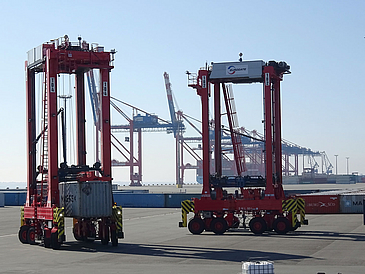Large container ships can transport more than 20,000 containers nowadays and shipping companies expect a quick turnaround where the mega container vessels dock. One of the key aspects of a ports ability to compete is the berthing time of ships. The shortest possible loading and discharging times are demanded and straddle carriers can play a central role for this. The special vehicles for terminal-based container transport, as well as the processes relevant to them, were assessed by the research and development project “STRADegy,” which has now been completed. BIBA - Bremen Institute for Production and Logistics at the University of Bremen and the terminal operator EUROGATE were project partners. They investigated the safety and efficiency by means of the networking and automatization of straddle carriers.
Optimized processes for loading and discharging are a prerequisite for high productivity when performing handling services. This enables a competitive advantage to be created and digitalization technologies offer multifaceted opportunities for this. Those are the summarized findings from the four-year project, which included the development of a test facility at the EUROGATE Container Terminal Wilhelmshaven. The use of driverless straddle carriers was assessed in terms of technology, organization, and economic viability.
Safety, Efficiency, and International Competitiveness
In Europe’s ports, straddle carries have been mainly exempt from automatization to date. They are considered particularly technically challenging. The aim of the STRADegy project was the development and testing of a high-performance automatization system. The system was to fulfill the requirements of mega terminals and growing ship sizes, be modular and scalable, and be fit for the future in terms of the system technology. Another important aspect was the implementation under the structural and climatic conditions of existing container terminals in North Europe. Furthermore, it had to be possible to integrate the system in running terminal operations with an acceptable effort. Safety, efficiency, and competitiveness were core principles.
Positive Results from Economic Simulation
In the project, several individual findings were made, for example concerning an entirely new basic safety architecture, as well as a norm-conform and easy separation of humans and machines during operations and repairs and maintenance. The combination of the automatic straddle carrier (auto-SC) with the manually operated container cranes for loading and discharging was another important success. One of the main requirements for this were the communication systems for these special needs. Communication architectures that fulfill the requirements reliably in terms of latency periods and data volumes were developed and tested as part of the project.
In order to analyze to what extent auto-SC is suitable for use in mega terminals with his operation loads, a combination of a process simulation and a computer emulation were applied. Amongst others, the economic viability simulations showed positive results.
Impulses for Further Developments
The observations concentrate on the safety, as well as technical and economic risks of the automatization of existing terminals. Guidelines for the creation of the supra structure, IT systems, handling processes, as well as change management were created. The findings and resulting recommendations highlight paths for the further development of container terminals and provide impulses for the future of German ports.
The STRADegy Project
The network project “Erforschung und Evaluation eines automatischen Containerumschlags unter Einsatz von Straddle Carriern” (STRADegy) ran for four years and received 9.5 million euros in funding. It was funded as part of the IHATEC initiative from the Federal Ministry of Transport and Digital Infrastructure and accompanied by the project sponsor TÜV Rheinland. BIBA - Bremen Institute for Production and Logistics at the University of Bremen was the research partner and the terminal operator EUROGATE was a development partner and coordinator. A test facility was erected at EUROGATE Container Terminal Wilhelmshaven as part of the project.
Further Information:
www.stradegy-projekt.de (in German only)
www.biba.uni-bremen.de/en.html
www1.eurogate.de/en/EUROGATE/Terminals
www.uni-bremen.de/en/
Contact:
Prof. Dr.-Ing. Michael Freitag
Institute Director
BIBA - Bremen Institute for Production and Logistics GmbH
Phone: +49 421 218-50002
Email: freprotect me ?!biba.uni-bremenprotect me ?!.de
Dipl.-Wi.-Ing. Stephan Oelker
STRADegy Project Leader (BIBA)
BIBA - Bremen Institute for Production and Logistics GmbH
Phone: +49 421 218-50130
Email: oelprotect me ?!biba.uni-bremenprotect me ?!.de

